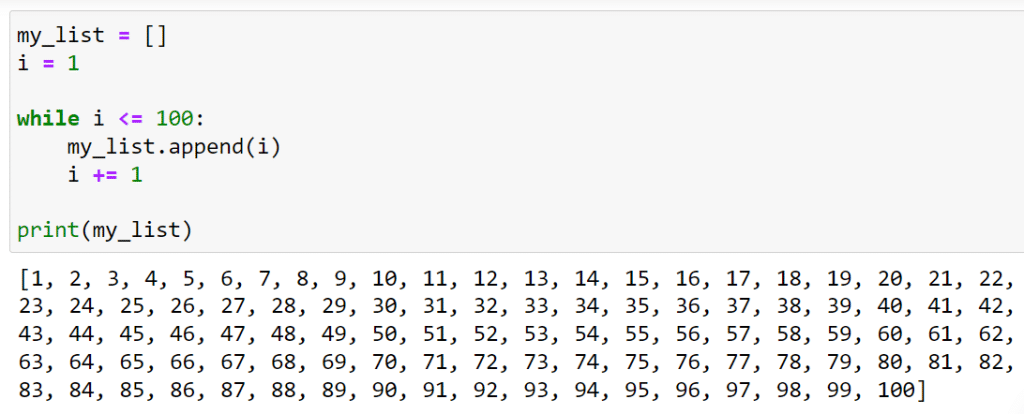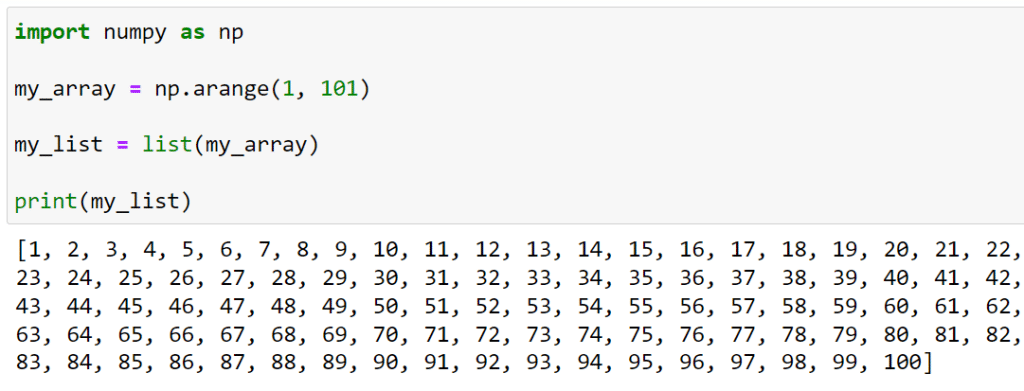Ready to make a list from 1-100 quickly and efficiently, well you’re in the right place!
To make a list from 1 to 100 in Python, you can use several methods. A frequently used method is list comprehension, which is an efficient way to create new lists. You can also use for loops to generate a list from 1 to 100 sequentially. Other methods include using the range() function with the list() function, using a while loop, using map() with lambda(), and using the itertools library.
In this article, we will cover all the important Python list methods of making a list from 1 to 100.
Each method will be followed by examples to help you better understand the concepts.
Also, after reading this article, you can make lists of any kind for your Python projects.
Let’s get into it.

7 Methods of Making a List From 1 to 100
In this section, we will go over the 7 best methods of making a Python list from 1 to 100.
Specifically, we will go over the following and provide code examples for each:
Using a For Loop
Using List Comprehensions
Using the range() function with list() function
Using a While Loop
Using map()
Using itertools
Using NumPy Library

1) How to Make a List From 1 to 100 Using a For Loop
To make a list from 1 to 100 using a for loop in Python, you can initialize an empty list and then use the for loop to iterate over a range of numbers from 1 to 100, appending each number to the list.
The following is an example of making a list from 1 to 100 using a for loop:
# Initialize an empty list
my_list = []
# Iterate over a range from 1 to 100
for i in range(1, 101):
my_list.append(i)In this code snippet, range(1, 101) generates numbers in the specified range, from 1 to 100 (since the end of the range is exclusive).
For each iteration of the loop, i takes on the next value in this range, and my_list.append(i) adds that value to the end of my_list.
After the loop completes, my_list contains the numbers from 1 to 100.

2) How to Make a List From 1 to 100 Using List Comprehension
Creating a list from 1 to 100 using list comprehension in Python is an efficient and the most favored way.
List comprehension is a syntactic construct available in Python for creating a list based on existing lists or iterables.
The following is an example of making a list from 1 to 100 using this method:
my_list = [i for i in range(1, 101)]In this one-liner, [i for i in range(1, 101)] is the list comprehension.
It iterates over range(1, 101) and for each iteration, the current value of i is added to the list.
The range(1, 101) function generates numbers from 1 to 100 (the upper limit 101 is exclusive).
The result is a list my_list containing integers from 1 to 100.

3) How to Make a List From 1 to 100 Using The range() Function
To make a list from 1 to 100 in Python using the range() function combined with the list() function, you can directly convert the sequence of numbers generated by range() into a list.
The Python range() function creates a range object, and the list() function then converts this range object into a list.
The following Python script is an example of making a list using this method:
my_list = list(range(1, 101))In this code, range(1, 101) generates a sequence of numbers from 1 to 100. The range’s start is inclusive (1), while the end (101) is exclusive.
Wrapping the range() function with list() converts the range object into a list containing all the numbers in the sequence.

4) How to Make a List From 1 to 100 Using a While Loop
To create a list from 1 to 100 using a while loop in Python, you’ll start with an empty list, then use the while loop to repeatedly add numbers to this list until you reach 100.
Follow the steps given below to make a list from 1 to 100 using a while loop:
Initialize an empty list.
Set a variable (typically i) to 1, as this is your starting number.
Use a while loop that runs as long as i is less than or equal to 100.
Inside the loop, append i to the list.
Increment i by 1 in each iteration.
The following is an example of making a list from 1 to 100 using a this method:
my_list = [] # Initialize an empty list
i = 1 # Start with 1
# Loop until i is greater than 100
while i <= 100:
my_list.append(i) # Append current value of i to the list
i += 1 # Increment iAfter this loop completes, my_list will contain integers from 1 to 100.

Loops give you the flexibility of defining your step values, which is helpful in numerous list applications.
5) How to Make a List From 1 to 100 Using The map() Function
You can also create a list from 1 to 100 using the map() function in combination with the range() and lambda functions.
The map() function applies a given function to each item of an iterable (like a list) and returns a map object (which is an iterator).
You can then convert this map object to a list.
The following is an example of making a list from 1 to 100 using this method:
my_list = list(map(lambda x: x, range(1, 101)))In this code, range(1, 101) generates a sequence of numbers from 1 to 100. lambda x: x is a simple lambda function that returns the value it receives.
map(lambda x: x, range(1, 101)) applies the lambda function to each element in the range, effectively creating an iterator over the numbers 1 to 100.
list(map(…)) converts this iterator into a list.

This method is also frequently used for making evenly spaced values in a list.
6) How to Make a List From 1 to 100 Using itertools Module
To create a list from 1 to 100 using the itertools module in Python, you can utilize the islice function in combination with count.
The itertools module is typically used for creating and working with iterators, and it provides advanced tools compared to the basic range function.
The following is an example of making a list from 1 to 100 using itertools module:
import itertools
my_list = list(itertools.islice(itertools.count(1), 100))In this code, itertools.count(1) creates an infinite iterator starting from 1. itertools.islice(itertools.count(1), 100) slices the first 100 elements from this iterator. list(…) converts this sliced iterator into a list.
The second parameter in the islice method is a stop parameter.
The output will be the same as the previous method:

7) How to Make a List From 1 to 100 Using The NumPy Library
To create a list from 1 to 100 using the NumPy library in Python, you can utilize NumPy’s arrange function, which is similar to Python’s built-in range function but returns an array.
After generating the NumPy array, you can easily convert it to a standard Python list.
This method is particularly efficient for large numerical data manipulations and is commonly used in scientific computing.
The following is an example of making a list from 1 to 100 using the NumPy library:
import numpy as np
my_array = np.arange(1, 101)
my_list = list(my_array)In this code, np.arange(1, 101) creates a NumPy array with numbers from 1 to 100. Then, list(my_array) converts this NumPy array into a standard Python list.

Want to check out our latest Python workflow, see our latest clip below:
Final Thoughts
Learning how to create a list from 1 to 100 in Python is a foundation for understanding list manipulation and iteration, which are key concepts in Python programming.
Whether you’re handling data, automating tasks, or just beginning your journey in coding, these methods equip you with the tools to manage and process sequences efficiently.
Each technique, from simple for loops to sophisticated NumPy arrays, offers a different perspective on handling data in Python. These methods are stepping stones to more complex and exciting coding challenges.
Frequently Asked Questions
In this section, you will find some frequently asked questions you may have when making lists in Python.

How can I create a list of numbers from 1 to 100 in Python?
You can easily create a list of numbers from 1 to 100 in Python using the range function.
To do this, simply use the following one-liner:
numbers_list = list(range(1, 101))
What is the Python syntax for generating a list with a range of numbers?
To generate a list with a range of numbers, use the range function along with the list() function, as shown below:
numbers_list = list(range(start, stop, step))
start: The first number in the range, inclusive.
stop: The last number in the range, exclusive.
step: The difference between consecutive numbers in the range.
For example, to create a list of even numbers between 1 and 20:
even_numbers = list(range(2, 21, 2))
How do I use the range function to create a list in Python?
The range function in Python is used to generate a sequence of numbers within a given range.
To create a list using the range function, pass the start, stop and optionally the step size, as arguments, and then convert the range object into a list.
Here’s an example of creating a list from 1 to 100:
numbers_list = list(range(1, 101))
What is the most efficient way to generate a list of consecutive numbers in Python?
The most efficient way to generate a list of consecutive numbers is to use the range function combined with the list() function.
This approach is both memory-efficient and fast.
consecutive_numbers = list(range(1, 101))
How can I populate a Python list with numbers from 1 to 100?
To populate a Python list with numbers from 1 to 100, you can simply use the range function along with list() to create a new list:
numbers_list = list(range(1, 101))
Can I create a list with descending numbers from 100 to 1 in Python?
Yes, you can create a list with descending numbers from 100 to 1 in Python.
Use the range function with a step size of -1 to achieve this:
descending_list = list(range(100, 0, -1))
This will create a list with numbers from 100 to 1 in descending order.








